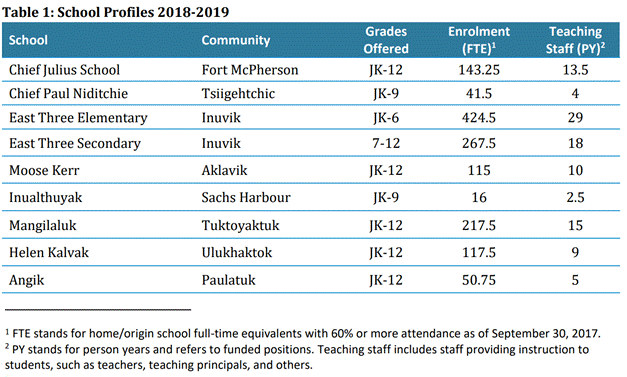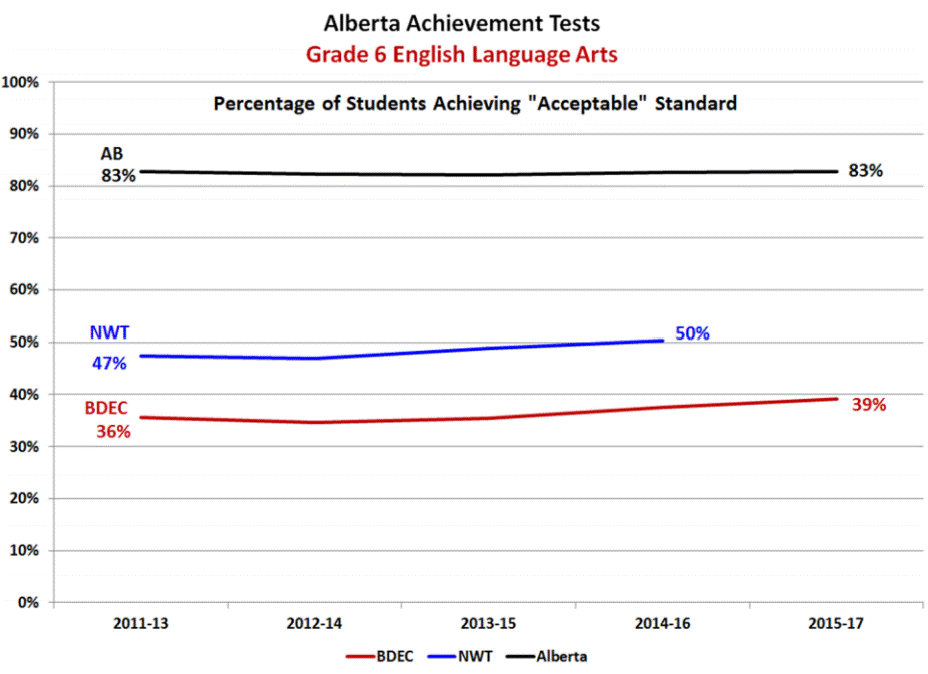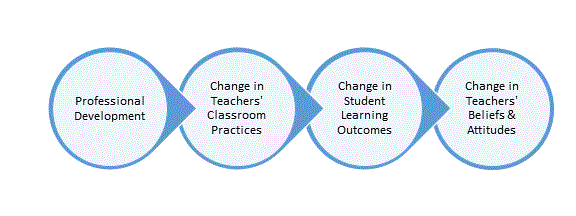Beaufort Divisional Divisional Education Council (BDDEC) is located in the Mackenzie Delta and Beaufort Sea area of the Northwest Territories. The school district is composed of nine schools servicing eight communities. Three of the communities, Ulukhaktok, Paulatuk, and Sachs Harbour, are only accessible via plane. Schools range in size, with Inualthuyak, in Sachs Harbour, having 16 students in the 2018/19 school year to East Three Elementary School, in Inuvik, having 424.5 students in the 2018/19 school year. The median school size is Helen Kalvak School in Ulukhaktok, with 117.5 students in the 2018/19 school year enrolled in Junior Kindergarten to grade 12. See Table 1 for the 2018-2019 school breakdown of BDDEC.

Note. Reprinted from Beaufort-Delta Divisional Education Council (BDDEC) Operating Plan for 2018-2019 School Year June 30, 2018. (https://www.ece.gov.nt.ca/sites/ece/files/resources/2018-19_bddec_operating_plan.pdf)
Student achievement, as measured by the Alberta Achievement Tests, has not increased in the past eight years in Math or English, as shown in figure 1 and 2. This has led the district to strategize ways to support teachers to increase the achievement of students. One option for this is to create a social network within the school system so that teachers have the opportunity to collaborate with each other, as well as teachers outside of the district.

Figure 1. Alberta Achievement Tests, Grade 6 Mathematics, 2018, retrieved from https://www.ece.gov.nt.ca/sites/ece/files/resources/2018-19_bddec_operating_plan.pdf.

Figure 2. Alberta Achievement Test Grade 6 English Language Arts, 2018, retrieved from https://www.ece.gov.nt.ca/sites/ece/files/resources/2018-19_bddec_operating_plan.pdf.
Michael Fullan (2016), in The elusive nature of whole system improvement in education questions why whole system change seems so hard to accomplish. “Whole system change involves two elements: deep pedagogical change based on the relationships among learnings (I include teachers and students as learners) and solutions that successfully address equity – that is, solutions that serve all, but especially serve the historically disaffected” (Fullan, 2016, p. 540). Whole system change and improvement is difficult to succeed. Using the wrong policy drivers with an emphasis on accountability and punitive measures will not lead to a system wide change. The culture of the system and collective efficacy will play a larger role in supporting a whole system change. Setting up and maintaining strong relationships, supported through infrastructure and policies, will be key in generating a cultural shift that is ready and supportive of a whole system change.
A key aspect that Fullan explores to support whole system change is the concept of coherence. “Coherence consists of the shared depth of understanding about the purpose and nature of the work” (Fullan & Quinn, 2016, p. 1). “Charismatic heroes will not save the day. Rather, we need leaders who create a culture of growth; know how to engage the hearts and minds of everyone; and focus their collective intelligence, talent, and commitment to shaping a new path” (Fullan & Quinn, p. 47). How can a district that contains such geographically isolated communities, with low numbers of teachers, reach a cohesive framework that helps drive positive change for our students?
Digital technology is providing access to peer supported networks from people across the world. Rincon-Gallardo and Fullan (2015), in Essential features of effective networks in education, explore essential features of effective networks in education.
All eight features are crucial and feed on each other” (p. 10). “The essential networks are as follows:
-
- focussing on ambitious student learning outcomes linked to effective pedagogy;
- developing strong relationships of trust and internal accountability;
- continuously improving practice and systems through cycles of collaborative inquiry;
- using deliberate leadership and skilled facilitation within flat power structures;
- frequently interacting and learning inwards;
- connecting outwards to learn from others;
- forming new partnership among students, teachers, families, and communities; and
- securing adequate resources to sustain the work. (Rincon-Gallardo & Fullan, 2015, p. 10)
There are possible challenges with leveraging social networks as agents of change for BDDEC. Generating networks for the sake of creating networks will not typically foster whole system change as they are more likely to be superficial in nature. If clear thought and direction is not leveraged in creating networks that clearly help distinguish between effective and ineffective practices can lead to harmful networks (Rincon-Gallardo & Fullan, 2015, p. 8). Adoption of the eight essential features should help alleviate this possibility. Rincon-Gallardo and Fullan found a challenge exploring social networks, namely that there was “scarce available evidence to date casually – or even co-relationally – connecting network activities with improved student learning” (Rincon-Gallardo & Fullan, 2015, p. 8). When this lack of evidence was presented in a blog post Social Networks and Student Achievement with requests for input, Bonnie Stewart (2019), from the theoryblog stated “there can be real power in connecting people around shared interests….my own stories would be partly about how networks have *shaped* my interests, and my awareness, and therefore my educational practices” (2019).
In 2017, Siciliano published the paper Professiona Networks and Street-Level Performance: How Public School Teachers’ Advice Networks Influence Student Performance. It has been shown that “schools with greater levels of teacher collaboration did indeed have significantly higher levels of student achievement” (Goddard, Goddard, & Tschannen, 2007, p. 892-893). Siciliano wanted to see if an increase in social networks would lead to an increase in performance for teachers. Networks can increase a teachers’ resources, specifically “relational resources, such as knowledge, skills, innovations, and support that flow between actors, rather than physical or financial resources” (Daly & Finnigan, 2011, as cited in Siciliano, 2017, p. 83). Siciliano did find multiple correlations between social networks and student achievement.
It is important to be purposeful in the composition of the networks and the members. Siciliano correlated an increase in teacher efficacy when they were networks with teachers that were more committed to their schools than those who connected with teachers that were less committed to their schools. “It is the quality of one’s social connections in schools, rather than the quantity that matter for influencing teacher performance in reading” (Siciliano, 2017, p. 89). This aligns with Rincón-Gallardo and Fullan (2015) creating a large number of networks to bring about whole system change can “produce superficial and even harmful practices if not accompanied with clarity and precision about the patterns of interaction that distinguish effective from inconsequential or even harmful networks” (p. 8).
In setting up social networks within BDDEC “a focus on substantially improving teaching and learning to develop deeper student learning and engagement (quality) and to reduce variability in performance (equity) [will provide] the best vehicle to collaborate effectively” (Rincón-Gallardo & Fullan, 2015, p. 10). Using student evidence and school performance can be drivers for change within the network. Providing schools an opportunity to share success, not for competition sake, but for a whole system improvement within BDDEC by using student evidence and school performance as drivers can allow any positive impacts to become visible. When the schools, teachers, and members become aware that they can actually improve and benefit student achievement, they will be more interested in actually changing their practices. Providing the networks clear levels of impact will help them see the benefits of working together (Rincón-Gallardo & Fullan, 2015). This aligns with Thomas Guskey’s model of teacher change, found on page 383 of Professional Development and Teacher Change (2002).

Figure 3. A model of teacher change. Adapted from ‘Professional Development and Teacher Change’ by T. Guskey, 2002, Teachers and Teaching, 8(3), p. 383.
Providing a platform for teachers to share their student growth will help teachers change their beliefs and make the teachers continue to self-improve, leveraging the network to continue their growth. For the network to be effective and allow sharing to happen within members, a high level of trust needs to exist. “While in high-stakes contexts the natural response of data comparing results creates defensiveness, environments of high trust turn transparency of data into a sense of moral urgency to get better and learn from others” (Rincón-Gallardo & Fullan, 2015, p. 14).
In structuring the social networks within the district, it is important to provide opportunities for teachers to network with those that have a strong desire to improve their own self-efficacy as “teachers tied to peers with greater levels of organization commitment tend to have a higher performance” (Siciliano, 2017, p. 91). The intent behind leveraging a network within BDDEC is to increase the capacity of teachers. This has to be strategic because Siciliano’s “findings imply that strategies designed to simply spur the creation of additional social ties among frontline workers may not lead to performance changes” (2017, p. 91). “Therefore, to see a return on investment, teachers may need to form connections to colleagues who are willing to share tacit knowledge and who are interested in the success of their peers” (Siciliano, 2017, p. 91).
To achieve the level of trust and vision of the networks BDDEC will initially need to provide external support and guidance in the form of a facilitator. This will allow the boundaries and expectations of the network to be clear and concise (Rincón-Gallardo & Fullan, 2017, p. 15). This is where the district level staff at BDDEC can play a large role in the formation and support of social networks. The two established networks within BDDEC, the Literacy Network, and the Numeracy Network, can use lead members to create more networks for further sharing and capacity building. The literacy and math consultants, having gained experience from running networks, can help facilitate and support other networks develop within BDDEC. Including the current network members would also bring validity to the networks because “the presence of senior leaders signals the importance of collaboration for the system, whereas the participation of actors from different levels of the system helps ensure that collaboration becomes embedded in the culture of the system” (Rincón-Gallardo & Fullan, 2015, p. 15).
Increasing the access of network member-to-member contact would need to be a priority. A problem with the current model of the Numeracy Network at BDDEC is that is only meets once a month, synchronously. Schools that had singleton network members did not seem as engaged in the changes the network was proposing in comparison to schools with multiple members. We are much more likely to establish new behaviours if we are exposed to a group of individuals exhibiting the same behavior, this can apply to anything, from eating to exercise (Rincón-Gallardo & Fullan, 2015, p. 16). “Interacting frequently with other colleagues whose work is improving student outcomes is thus one of the most powerful strategies for continuous improvement and innovation” (Rincón-Gallardo & Fullan, 2015, p. 16). If BDDEC is going to be leveraging social networks to further support change, providing a method for more frequent communication will be required. This is where a platform like Twitter may be a benefit. Rincón-Gallardo and Fullan (2015) state that communicating outside of the network is important because it can prevent the group from circulating the same ideas. Twitter would allow network members exposure to new ideas. Bonnie Stewart (2019) pointed out that there are
so many things I’d never even have known about if it weren’t for educational/academic Twitter that have come to guide the way I approach my work. I learned the word “heutagogy” from my network, I learned about Critical Race Theory from my network, I learned about the idea of Universal Design for Learning from my network.
In the creating of social networks, there needs to be fundamental shifts to the system. We need to move from a supply driven district to a demand driven. This is the fear of a top down approach forcing the networks to work. Leadership can play a role in the inspiration of the vision, but the networks need to be places of collaboration where the members are able to have input into, and control of their agenda. “A ‘gradual release of responsibility’ approach whereby support and intervention from external facilitators diminishes as internal capacity increases is adequate for the purposes of enhancing effective collaboration in networks across entire systems” (Rincón-Gallardo & Fullan, 2015, p. 18). BDDEC also needs to shift form needing teachers to be compliance orientated to looking inwards and wanting to improve themselves and their learning. Learning needs to be the focus of BDDEC, student learning, teacher learning, administration learning. The role of leadership needs to shift from authoritative to a position of leader learner. (Rincón-Gallardo & Fullan, 2015). Moving along this lens, we need to move away from a bureaucratic approach to one where we need to allow teachers autonomy in how they deepen their own growth to support their students, and then given the freedom to provide their students with the education that they need. (Rincón-Gallardo & Fullan, 2015). This shift can only happen when there is enough capacity and professionalism within all members with a clear level of internal accountability put in place. Social networks can provide the support for a system such as this, with teachers holding each other accountable due to sharing the same goal of maximizing the learning of our students.
A social network can be a tool to support whole system change. It needs to have purpose, design, intent, teacher buy in, interest, and be accessible. Creating a back channel Twitter network within the district could be a powerful tool to help support this, provided teachers can become educated in the use of Twitter, and in the benefits that it would bring to them.
References
Beaufort Delta Divisional Education Council. (2018). Operating Plan for 2018-19 School Year, June 30, 2018. Yellowknife, Canada; Education, Culture, and Employment, Government of the Northwest Territories. Retrieved from https://www.ece.gov.nt.ca/sites/ece/files/resources/2018-19_bddec_operating_plan.pdf
Fullan, M. (2016). The elusive nature of whole system improvement in education. Journal of Educational Change, 17(4), 539-544. https://doi.org/10.1007/s10833-016-9289-1
Fullan, M., & Quinn, J. (2016). Coherence: The Right Drivers in Action for Schools, Districts, and Systems. Thousand Oaks, California: Corwin
Goddard, Y., Goddard, R., & Tschannen-Moran, M. (2007). A theoretical and empirical investigation of teacher collaboration for school improvement and student achievement in public elementary schools. Teachers College Record, 109(4), 877-896. Retrieved from https://pdfs.semanticscholar.org/c8a9/b72926d14e3632290af4d7eb1de5f175bd2f.pdf
Guskey, T. R. (2002). Professional development and teacher change. Teachers and Teaching, 8(3), 381-391. https://doi.org/10.1080/135406002100000512
Rincón-Gallardo, S., & Fullan, M. (2016). Essential features of effective networks in education. Journal of Professional Capital and Community, 1(1), 5-22. https://doi.org/10.1108/JPCC-09-2015-0007
Siciliano, M. D. (2017). Professional networks and street-level performance: How public school teachers’ advice networks influence student performance. The American Review of Public Administration, 47(1), 79-101. https://doiorg/10.1177/0275074015577110
Stewart, B. (2019, July 15). Social Networks and Student Achievement [Blog comment]. Retrieved from https://adamgwright.opened.ca/2019/07/15/social-networks-and-student-achievment/
Resources that I found useful, so maybe you will too:
https://sites.google.com/view/bc-numeracy-network – BC has a Numeracy Network
http://theory.cribchronicles.com/ – Bonnie Stewart’s blog (her portfolio is at: http://bonstewart.com/) You can also follow her on Twitter: @bonstewart.
Sunil Singh (@mathgarden) interesting individual to follow on Twitter, if you are interested in math discussions.
https://www.maa.org/external_archive/devlin/LockhartsLament.pdf – Just a great read about why we are actually teaching math.
https://technolandy.wordpress.com/ – Ian Landy’s (@technolandy) site and blog, a lot of deep pedagogical thought and insights go on here. Ian recommended following Sunil Singh and linked to A Mathematician’s Lament on my blog.
David Truss has a great webpage and blog to follow: http://pairadimes.davidtruss.com/ He is also active on Twitter, @datruss.
David also recommended I read a book by Danah Boyd called ‘Its Complicated” (available for free online) on Danah’s website: https://www.danah.org/. You can also follow Dahah on Twitter, @zephoria, and view her blog: http://www.zephoria.org/thoughts/
Terry Elliot(@telliowkuwp) recommended I read Jay Cross’ “Informal Learning”.
Greg McVerry (@jgmac1106) has an interesting website, with a blog, and linked articles: http://jgregorymcverry.com/.
Verna Roberts (@verenanz) has an excellent blog post about open learning and the benefits of social networks: http://www.openclassroomonline.com/proposing-oldi-version-1-an-open-learning-design-intervention-for-k-12-open-educational-practice/
Of course, I have to include directs to Michael Fullen’s two books that I leaned on for support: “Coherence” and “Deep Learning.”
Recent Comments